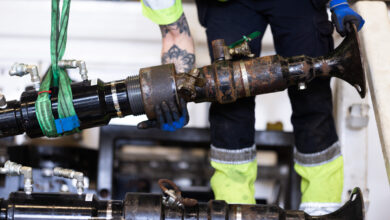Mexico’s National Data Repository to share seismic, well data to attract investment
By Kelli Ainsworth, Editorial Coordinator

In December, the Mexican National Commission of Hydrocarbons (CNH) announced it would auction 10 deepwater blocks at a yet-to-be-determined date. To provide oil companies with data in an effort to encourage more participation, CNH’s National Data Repository (NDR) is preparing to release all seismic and well data collected by PEMEX and the Mexican Petroleum Institute (MPI) up to August 2014. “For us, one of the most important things is information,” Oscar Roldan, Head of the NDR, said in a presentation hosted by the Petroleum Exhibition and Conference of Mexico on 3 December in Houston. “As long as we manage to create a healthy information industry within the country, we are sure that knowledge of our basins will increase and attract more investment for our future bid rounds.”
Some of the data – including 3D seismic data from 20 surveys in the deepwater GOM and data from 55 deepwater GOM exploration wells – is already available through NDR. The group anticipates it will complete the process of gathering the rest of the historic data from PEMEX and MPI by August 2016, Mr Roldan said. Data will be accessible in three ways: through data packs, licenses and multiclient surveys.
Data packs are released in conjunction with bidding rounds and pertain to the areas up for auction, Mr Roldan said. In 2015, Mexico held its first bidding rounds in more than 80 years, following a series of energy reforms. The Mexican government has awarded a number of production contracts onshore and in shallow water, as well as offshore exploration contracts. CNH delivered 132 data packs for the first three bids of Round One. Companies that purchase data packs can visit the NDR office to explore the data further. “They have the chance to go to our office and see all the information that we’re delivering to them in the data pack loaded into a platform to visualize and analyze,” he said.
The NDR has also created a licensing system whereby companies can purchase more in-depth data about different basins. During bid rounds in 2015, Mr Roldan said, companies complained that the data packs were not extensive enough and that the data was difficult to understand. “That gave us the signal to start creating this new license system in which companies can access the full survey and all the different version of the seismic.” The first surveys that have been offered through this system pertain to the deepwater GOM. “The idea is to try to support companies that are going to be interested in the deepwater bid round.”
NDR also authorized 28 multiclient projects in 2015. Of these, 19 involve the acquisition of new data, and nine are focused on reprocessing existing data. “All of the acquisition and reprocessing of new data that they are going to do is in the Gulf of Mexico,” Mr Roldan said. “It’s a huge bank of information related to the GOM.”
The fees for the NDR’s data vary according to the amount and type of data requested. Mr Roldan stated that the NDR opted for a price scheme that would be fair to the geophysical companies who are themselves investing millions of dollars to acquire and sell data on Mexico’s basins. “The idea when we were releasing this data was that we would set the prices high enough so there would be an interesting market for the geophysical companies and it could accommodate their products,” he said.




